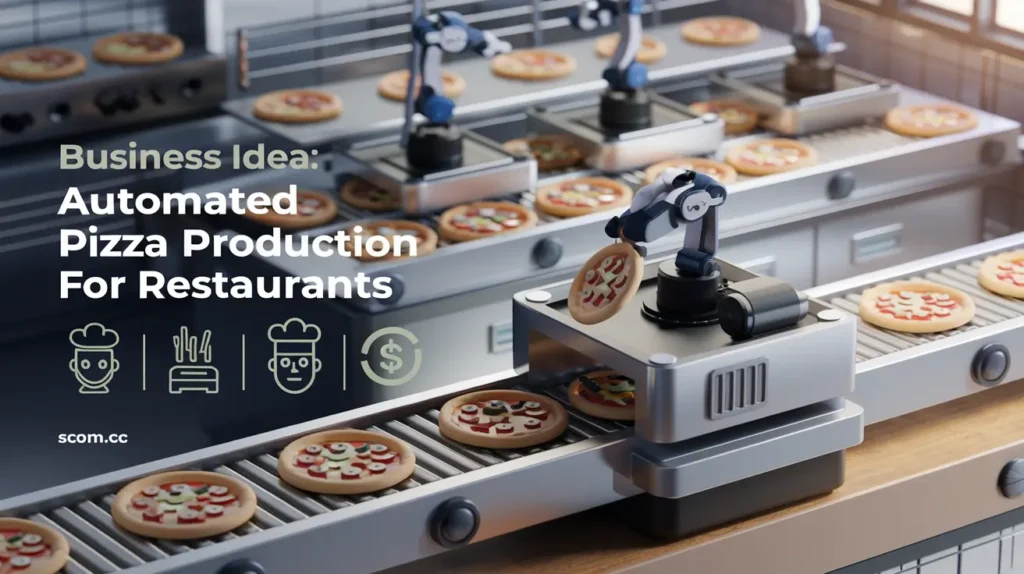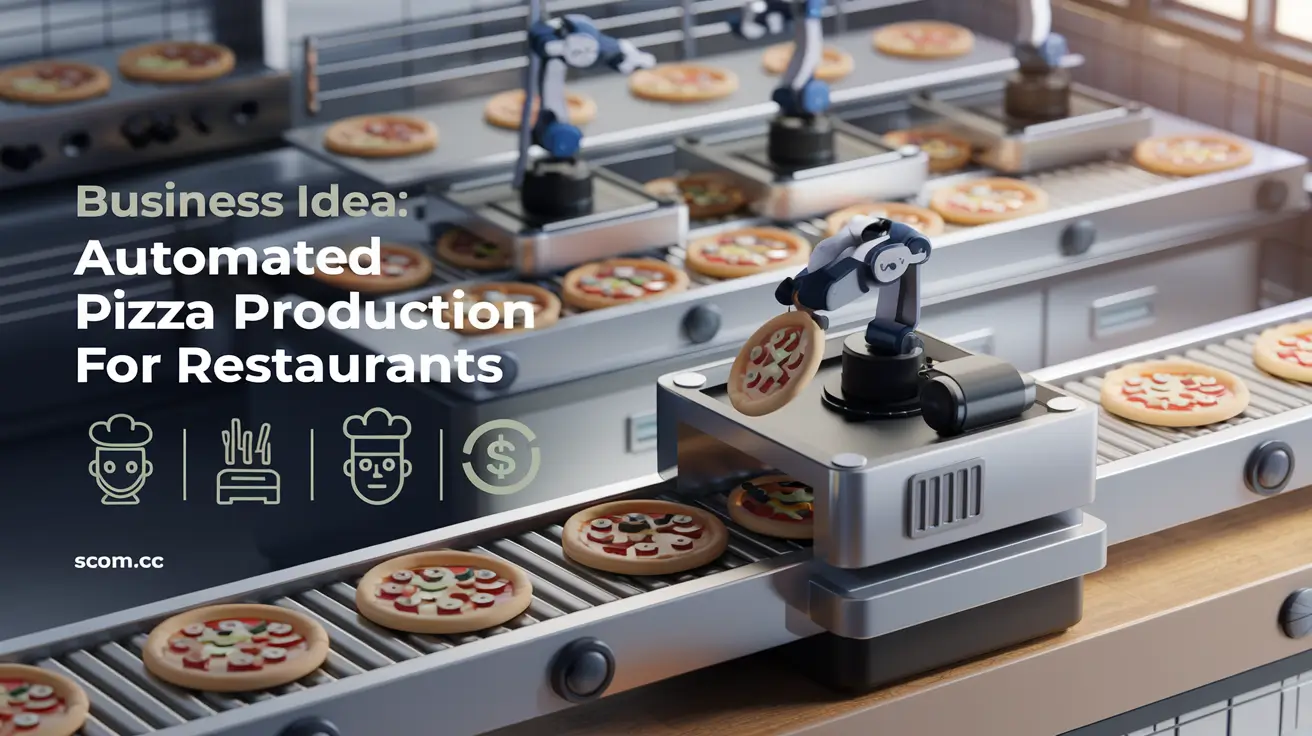Business Idea Automated Pizza Production for Restaurants

- Business Idea Automated Pizza Production for Restaurants
- Introduction to Automated Pizza Production
- What Is Automated Pizza Production?
- Market Potential for Automated Pizza Production
- Initial Costs and Investment
- Benefits of Automated Pizza Production
- Challenges and Considerations
- Legal and Regulatory Aspects
- Marketing and Placement Strategies
- Future Trends and Innovations
- Conclusion
- Summary Table
-
FAQ
- What is automated pizza production?
- What are the initial costs for starting an automated pizza production line?
- What are the main benefits of automated pizza production?
- What challenges might businesses face with automated pizza production?
- What legal and regulatory aspects should be considered?
- How can businesses effectively market their automated pizza production services?
- What are the future trends in automated pizza production?
Business Idea Automated Pizza Production for Restaurants
Automated Pizza Production for Restaurants: Revolutionizing the Food Industry
Offer an automated line for pizza production, optimizing preparation and cooking for high-demand restaurants and pizzerias.
Introduction to Automated Pizza Production
The food service industry is continually evolving, with restaurants and pizzerias seeking innovative ways to meet increasing consumer demands while maintaining high quality. Automated pizza production lines offer a solution by streamlining the preparation and cooking process, enabling high-demand establishments to produce consistent, delicious pizzas efficiently. This guide explores the concept of automated pizza production, its market potential, benefits, costs, and key factors for establishing a successful business.
What Is Automated Pizza Production?
Automated pizza production involves the use of machines and technology to handle various stages of pizza preparation, from dough processing to topping application and baking. These systems are designed to optimize efficiency, reduce manual labor, and ensure consistent quality in every pizza produced.
Key Components of an Automated Pizza Production Line
- Dough Processing Machines: Automate the mixing, kneading, and portioning of pizza dough.
- Topping Applicators: Precisely distribute toppings such as sauce, cheese, and other ingredients.
- Conveyor Ovens: Ensure consistent baking by moving pizzas through a temperature-controlled environment.
- Packaging Systems: Automate the packaging of pizzas for delivery or takeaway.
Market Potential for Automated Pizza Production
The demand for quick and consistent pizza production is high, especially in busy restaurants and pizzerias. Automated systems cater to this need by enabling businesses to handle large volumes without sacrificing quality.
Target Markets
- High-Demand Restaurants and Pizzerias: Establishments that require fast and efficient pizza production to meet customer demand.
- Chain Restaurants: Large chains that need consistent pizza quality across multiple locations.
- Food Delivery Services: Businesses that deliver pizzas and require quick preparation to fulfill orders on time.
- Event Catering Services: Catering companies that need to produce large quantities of pizzas for events and gatherings.
Initial Costs and Investment
Starting an automated pizza production line involves significant initial costs, primarily for purchasing equipment and setting up the production area. However, the investment can lead to long-term savings through increased efficiency and reduced labor costs.
Cost Breakdown
- Pizza Production Machines: The cost of a full automated line can range from $50,000 to $300,000, depending on the level of automation and capacity.
- Facility Setup: Expenses for setting up the production area, including space, utilities, and installation of machinery.
- Raw Materials: Ongoing costs for pizza ingredients such as dough, sauce, cheese, and toppings.
- Labor and Training: While automation reduces manual labor, there will still be costs associated with hiring and training staff to operate and maintain the machines.
Benefits of Automated Pizza Production
Automated pizza production offers numerous advantages, making it an attractive option for high-demand restaurants and pizzerias looking to improve efficiency and consistency.
Advantages
- Increased Production Capacity: Automation allows for the production of large quantities of pizzas in a short amount of time, meeting high customer demand.
- Consistency: Ensures uniform quality across all pizzas, reducing human error and variability.
- Labor Savings: Reduces the need for manual labor, allowing staff to focus on other aspects of the business.
- Faster Service: Speeds up the preparation and cooking process, resulting in quicker service for customers.
- Cost Efficiency: While the initial investment is high, the long-term savings from labor and waste reduction can offset the costs.
Challenges and Considerations
While automated pizza production offers significant benefits, there are challenges and considerations that businesses must address to ensure successful implementation and operation.
Common Challenges
- High Initial Investment: The cost of purchasing and setting up an automated production line can be substantial.
- Maintenance and Repairs: Ongoing maintenance is required to keep the machinery in optimal condition, and repairs can be costly.
- Technology Dependence: Reliance on technology means that any system failures or malfunctions can disrupt production.
- Customization Limitations: While automation ensures consistency, it may limit the ability to customize pizzas for specific customer preferences.
- Training Requirements: Staff must be trained to operate the machinery and troubleshoot any issues that arise.
Legal and Regulatory Aspects
Operating an automated pizza production line requires compliance with various legal and regulatory standards. Ensuring adherence to these requirements is essential for maintaining product safety and quality.
Key Regulations
- Food Safety Standards: Compliance with food safety regulations, including proper hygiene, sanitation, and temperature control.
- Health and Safety Regulations: Ensuring that the production area is safe for workers, with proper safety protocols in place.
- Labeling and Packaging Requirements: Accurate labeling of ingredients, nutritional information, and allergen warnings for packaged pizzas.
- Environmental Regulations: Adherence to regulations related to waste management, energy usage, and emissions.
Marketing and Placement Strategies
Effective marketing and placement strategies are crucial for promoting automated pizza production services and attracting potential clients. A strong market presence can help businesses reach a wider audience and drive growth.
Marketing Tips
- Highlight Efficiency: Emphasize the speed and consistency of automated pizza production in marketing materials.
- Target High-Demand Markets: Focus on restaurants, pizzerias, and food delivery services that require quick and reliable pizza production.
- Develop a Strong Brand: Create a professional brand image that conveys quality and innovation.
- Leverage Online Platforms: Use social media, websites, and online advertising to reach potential clients and showcase the capabilities of the automated system.
Future Trends and Innovations
The food industry is constantly evolving, and automated pizza production is no exception. Staying informed about emerging trends and innovations can help businesses stay competitive and adapt to changing market demands.
Emerging Trends
- Customization Options: Advances in automation technology may allow for greater customization of pizzas, catering to specific customer preferences.
- Sustainable Practices: Increased focus on sustainability, including energy-efficient machinery and eco-friendly packaging materials.
- Integration with Digital Ordering: Automation systems integrated with online ordering platforms can streamline the entire process from order placement to delivery.
- Smart Technology: The use of AI and IoT (Internet of Things) to monitor and optimize production processes in real-time.
Conclusion
Automated pizza production offers a valuable opportunity for restaurants and pizzerias to enhance efficiency, consistency, and customer satisfaction. By understanding the market potential, managing initial costs, and addressing challenges, businesses can successfully implement and grow their automated pizza production operations. With a focus on innovation, quality, and effective marketing, this business model can meet the increasing demand for quick and consistent pizza in the food industry.
Summary Table
| Aspect | Details |
|---|---|
| Service | Automated pizza production for high-demand restaurants and pizzerias |
| Key Features | Dough processing, topping application, conveyor ovens, packaging systems |
| Target Markets | High-demand restaurants, pizzerias, chain restaurants, food delivery services, event catering |
| Initial Costs | $50,000 to $300,000 for machinery, plus facility setup, raw materials, and labor |
| Benefits | Increased production capacity, consistency, labor savings, faster service, cost efficiency |
| Challenges | High initial investment, maintenance and repairs, technology dependence, customization limitations, training requirements |
| Legal Requirements | Food safety standards, health and safety regulations, labeling and packaging requirements, environmental regulations |
| Marketing Strategies | Highlight efficiency, target high-demand markets, develop a strong brand, leverage online platforms |
| Future Trends | Customization options, sustainable practices, integration with digital ordering, smart technology |
FAQ
What is automated pizza production?
Automated pizza production involves using machines and technology to handle various stages of pizza preparation, including dough processing, topping application, baking, and packaging.
What are the initial costs for starting an automated pizza production line?
Initial costs include $50,000 to $300,000 for machinery, plus expenses for facility setup, raw materials, and labor.
What are the main benefits of automated pizza production?
Benefits include increased production capacity, consistent quality, reduced labor costs, faster service, and long-term cost efficiency.
What challenges might businesses face with automated pizza production?
Challenges include high initial investment, ongoing maintenance and repair costs, dependence on technology, and potential limitations in pizza customization.
What legal and regulatory aspects should be considered?
Businesses must comply with food safety standards, health and safety regulations, accurate labeling and packaging, and environmental regulations.
How can businesses effectively market their automated pizza production services?
Effective marketing strategies include highlighting the efficiency and consistency of automated systems, targeting high-demand markets, building a strong brand, and utilizing online platforms for promotion.
What are the future trends in automated pizza production?
Emerging trends include increased customization options, sustainable practices, integration with digital ordering platforms, and the use of smart technology to optimize production processes.

If you enjoyed this article and found it valuable, we encourage you to explore our news and valuable information section, where you'll find more relevant and up-to-date content that may pique your interest. Additionally, if you are seeking advice or need guidance on a specific topic, we suggest visiting our services section. There, you will find a variety of options designed to assist and support you in addressing your needs. Feel free to check out both sections to get the information and assistance that best suits your requirements.

Leave a Reply